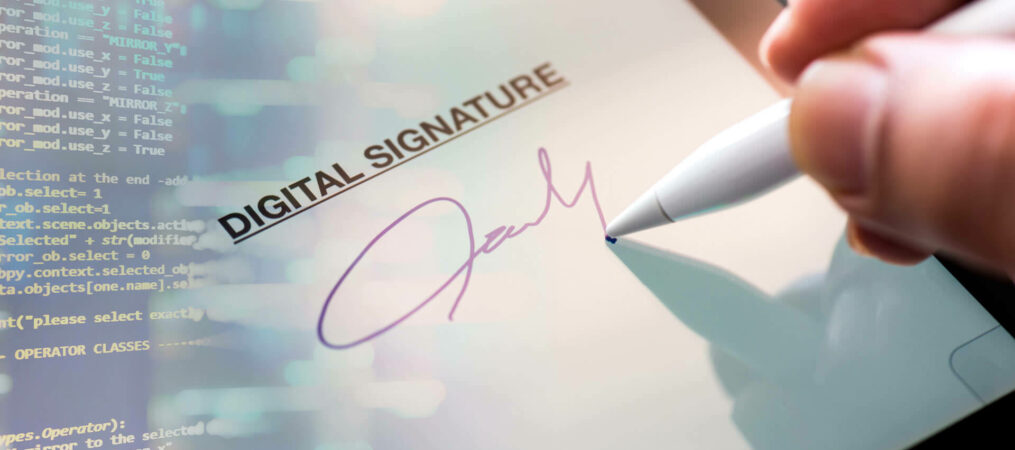
Digital signatures have become an essential component of doing business in an increasingly paperless world. The need to authenticate documents and collaborate in contract agreements has led to the emergence and popularity of a new way of signing documents remotely.
To put it into perspective, the global digital signature market is expected to reach a value of about $3.2 billion by 2022; that’s at a CAGR of 30% from 2016.
So, how do digital signatures work, and more importantly, how can you implement digital signing in your transaction processes to ease the tasks of signing documents? Let’s get answers to these and more questions as we take an in-depth look at the key details of digital signatures, their benefits, and modes of implementation.
How Does a Digital Signature Work?
Basically, a digital signature works like a traditional signature on a paper document; only this time, it's online and on soft/digital documents. The whole process is pretty simple. Someone sends the document via an email that redirects you to the signing platform, and all you have to do is press sign and consent to the agreements. However, things are a bit more complicated behind the scenes.
The signatures are enabled by a public key cryptography algorithm referred to as asymmetric cryptography. The action of signing a document generates a pair of encrypted keys – a public key and a private key. The software also generates a large numerical number based on the contents of the documents called a hash value, which acts as a digital fingerprint. The keys are used to encrypt and decode the hash value to validate the document.
Once the document is signed, the public key allows the recipient’s computer to interpret the hash value and compare it to the contents of the document. The private key remains with the person who signed the document and is used as an authentication key for the signature. If any details on the record are changed, any digital signatures become invalid.
Differences Between Digital Signatures and Electronic Signatures
The term "electronic signature" or "E-signature" is synonymously used in most cases to refer to digital signatures. However, despite serving roughly the same purpose as digital signatures, E-signatures are very different in terms of sophistication and the level of security.
An electronic signature is described as any electronic symbol, sound, or process that can be added to a digital file to express the user’s intention to sign the document. An electronic signature can be anything from an image to a simple tick in a box.
The main difference between E-signatures and digital signatures is that digital signatures have a very elaborate and secure method of authenticating signers and tracking the signed document to validate its integrity. Although E-signatures are also legally binding, digital signatures cover a broader range of legal requirements. For this reason, E-signatures are used in most cases to merely indicate consent while digital signatures are used on sensitive documents in highly regulated fields, including the legal, medical, and insurance industries.
The Legality of Digital Signatures
The encryption and authentication processes of digital signatures go through various levels of security. Many countries, including the U.S, Canada and most of Europe and Asia, consider digital signatures safe enough to be legally binding and enforceable.
Legally speaking, Canada has a friendly approach when it comes to digital signatures. Although contract law in Canada is provincial, the larger umbrella of federal legislation also dictates the rules surrounding written agreements and digital signatures.
The federal law allows the use of digital signatures under the 2004 Personal Information Protection and Electronic Documents Act (PIPEDA). The law regards digital signatures as equivalent to physical signatures and as legally binding. However, digital signatures must follow strict requirements to be admissible in a court of law.
- The signature must be unique and distinctive
- The signature must be created under the signer’s sole control
- The identity of signers can be confirmed
- Changes made on the document must be traceable
Nine of the ten provinces use the Uniform Electronic Commerce Act (UECA) to regulate digital signatures. Only the Quebec province has a unique set of laws that fall under the Act to Establish a Legal Framework for Information Technology. Nevertheless, the provisions under PIPEDA, UECA, and Quebec’s legislation are relatively similar.
So, you can sign contracts, proposals, transaction documents, and any agreements digitally in Canada. There are however a few exceptions where you still need to sign documents by hand, for instance:
- Court documents
- Trusts, Wills, and codicils
- Some real estate contracts
- Divorce and adoption papers
- Some powers of the attorney
Advantages of Using Digital Signatures
The goal of using digital signatures is to eliminate the need and effort of signing a physical document. Secondly, digital signatures minimize incidences where an already signed document might be manipulated as a malicious attempt at fraud.
Imagine having a document that needs signatures from several business associates, clients or contractors who are overseas. The traditional option would be to mail each person a copy of the document, then collect them all and compile the final record. This would waste a lot of time and money.
Using a digital signing service, you only need to circle one document for everyone to sign, and you won't spend a penny on postage. On average, businesses save between 55% and 78% of their document signing budget when using digital signatures and up to 22,000 hours annually according to this report.
Integrating Digital Signatures to Your Business Processes
DocuSign, eSignLive, and Adobe are some of the leading global companies offering digital signature services. Each service provider offers a variety of consumer service models; many of them let you select the particular feature and functions, including security protocols that best suit your organization’s needs.
The fees are usually on a subscription basis, and you can either use the platform as a third-party service provider or integrate the service's API to your IT infrastructure. The third-party services are ideal for small businesses that only require digital signing occasionally. API integration is a more convenient solution for businesses with much higher demands for digital signatures.
Final Thoughts
It’s essential as a business to stay ahead of digital trends and adopt new technologies that improve the efficiency of everyday business operations. Implementing innovative solutions not only gives you a competitive edge but also saves you valuable time and resources. Digital signing is one of these innovations that has completely revolutionized a business practice that has existed for centuries.
Don’t hesitate to get in touch with us for more information about digital signatures, including their implementation, customization, and available solutions. At Convergine, we are always eager and happy to help organizations adopt the latest digital solutions to modernize and streamline their business operations.












